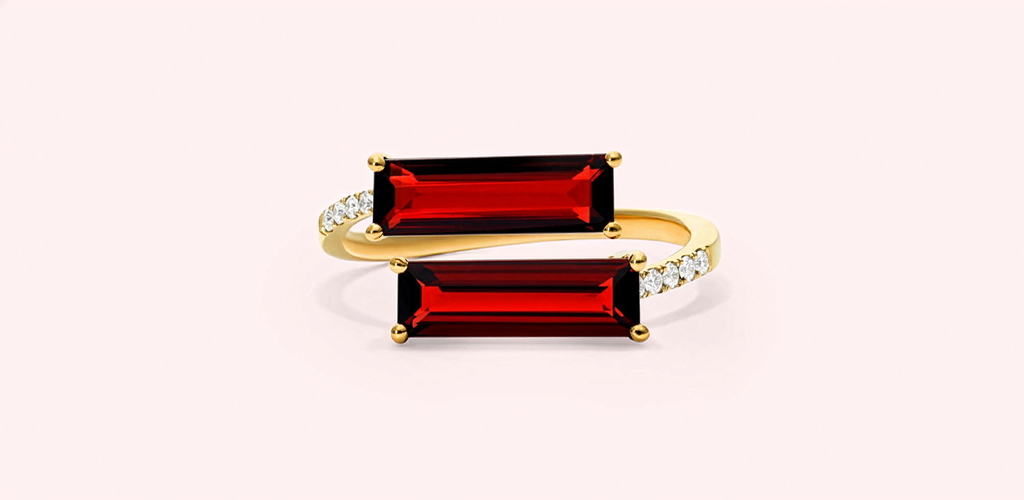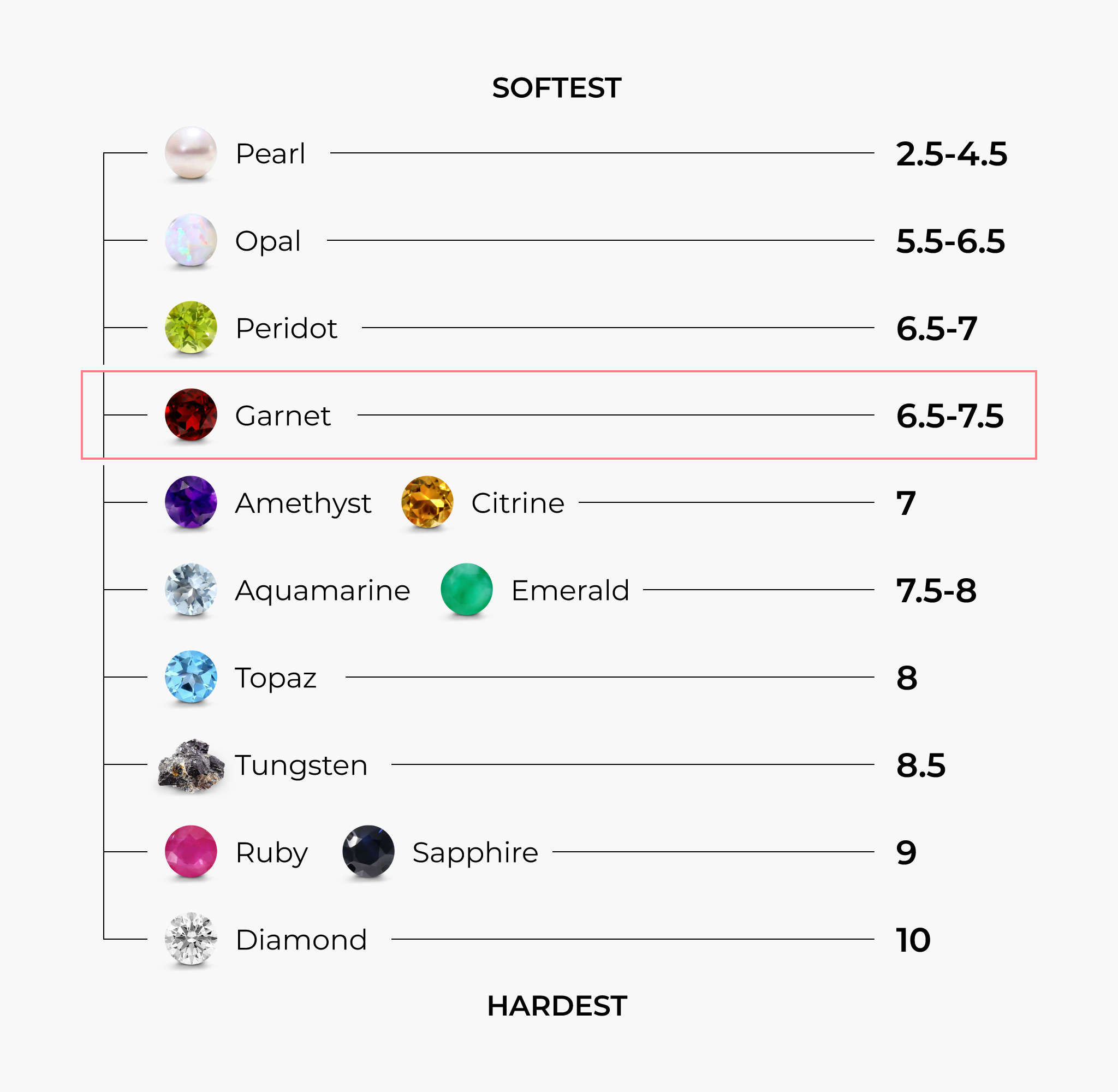
Garnet, the official January birthstone, contains so much more character than the familiar red radiance we often picture. With surprising color varieties, symbolism associated with Greek myths and royalty, and a durability suitable for everyday wear, garnets are truly versatile stones.
Help a loved one born at the beginning of the year embrace their deep and fiery garnet birthstone. Take a closer look at this beloved gemstone’s meaning, how to take care of it, tips for choosing the right pieces, and some beautiful birthstone alternatives.

While January’s birthstone is best known for its captivating red varieties, garnet is actually a group of closely related minerals with a wide range of colors. So, when buying gemstones, you may be surprised to come across garnets ranging from fiery red to vibrant greens.
Here are several different types of garnet:
A garnet usually forms as a blend of two or more of these species, with one dominant type guiding the stone’s classification. It’s extremely uncommon to find a garnet of a 100% pure species.
As for durability, garnet ranks between 6.5 and 7.5 out of 10 on the Mohs Scale of Hardness, making it fairly resistant to scratches and therefore a good choice for daily wear.
Note: Unlike many gemstones that are heat or radiation-treated to enhance their color, garnet’s rich hues occur naturally.

The International Gem Society traces garnet as a symbol of protection throughout history. The Crusaders wore garnets as protection from harm during battles. Royalty, like Queen Victoria, Mary Queen of Scots, and the Russian Czarinas, also donned garnets for protection.
Thanks to its most commonly known red variety, garnet also symbolizes blood, the heart, and vitality.
Because the name for garnet comes from pomegranates, garnets are also associated with the Greek myth of Persephone. In the story, the goddess of spring eats pomegranate seeds, which bind her to the underworld.
Garnets have been used since at least 3,000 BC, when the ancient Egyptians adorned their pharaohs with garnet jewelry in their tombs. From around 27 BC onward, the ancient Romans used intricately carved garnets for signet rings, which they used to seal important documents.
Legends suggest that garnets were used to illuminate Noah’s ark from the Bible. By the 1500s, garnet became a staple for European royals and their fine jewelry collections, cementing its status as a regal gem.
The word garnet comes from the Latin word granatus for pomegranate, thanks to its deep red color, just like the seeds. The word has also evolved from Middle English expressions linked to the term for dark red in the 1200s.
Predominantly sourced from Africa, garnets are also mined in India, Russia, and parts of Central and South America.
While garnet is a fairly durable stone, it’s more susceptible to damage than rubies or diamonds. Garnet jewelry can be long-lasting, but only with the proper care. Make sure to follow the tips below to keep your January birthstone jewelry shining all year long.
Here’s how to clean garnet jewelry:

Other cleaning options include:
You should never steam clean your garnet jewelry because the heat can crack or damage the stone. When you’re not wearing them, store your garnet pieces in soft fabric jewelry boxes or bags, away from other hard gemstones. This should prevent them from getting scratched.
Start your search for the perfect garnet by considering your color preference. Even classic red garnets come in a wide range of hues, from lighter shades to more saturated, velvety reds.
Once you know your ideal color depth, focus on clarity, cut and size. Look for minimal inclusions (imperfections in the stone) to keep the garnet looking clean and clear. A good, well-executed cut will allow more light into the stone to let it shine.
Finally, as you balance color with carat preference, keep in mind that garnet is naturally dense, so the larger the stone, the darker it appears.
Next, consider metals. Red garnet looks great in both gold and silver, so consider your recipient’s taste in jewelry metals if you’re giving this classic gem as a gift. If they favor warm palettes, red garnet halo studs set in yellow gold will probably complement their existing wardrobe.
If your loved one favors cool tones, consider a garnet birthstone necklace set in platinum or white gold.
While garnet is the only official birthstone for January, two other stones are associated with the month: rose quartz and black onyx.
Sellers could have begun associating these stones with January to offer alternatives to garnet on two opposite ends of a spectrum—rose quartz offers a lighter and softer aesthetic, while onyx is darker and bolder.
Associated with love and romance, rose quartz is known for its light, cotton candy-pink hue. Ancient Egyptians and Romans used it in beauty rituals, linking the stone to youthfulness.
With a 7 on the Mohs Scale of Hardness, rose quartz is somewhat durable, but it can fracture more easily than other stones. If you love the look of rose quartz jewelry, make sure to choose pieces with protective settings like a bezel.
Black onyx is a dramatic, opaque and inky color. Thanks to its striking darkness, some associate onyx jewelry with strength—for example, a pair of onyx drop earrings can signify resilience during the cold winter of January.
At a 6.5 to 7 on the Mohs Scale of Hardness, onyx is slightly durable yet can chip or scratch if knocked against a hard surface.
Garnet’s versatility gives those with January birthstones so many gorgeous color varieties to choose from, all laden with symbolic meaning and powerful history. And even if you still aren’t sold, rose quartz and onyx are equally beautiful backups.
At James Allen, we’re committed to helping you find jewelry for all your meaningful moments in life. With elevated styles and honest pricing, we’re your stop for gifts, engagements, and self-expression. Browse our selection of garnet jewelry and find a piece to call yours.
Technically, no, garnet is the only official birthstone of January. However, some people consider rose quartz and black onyx the unofficial January birthstone alternatives.
Because garnet is January’s birthstone, and the most common types of garnets are red, January is associated with a rich, deep red color. However, many people aren’t aware that garnet comes in many other colors, including orange and green.
Late November or early January is a great time to buy garnet jewelry for someone with a January birthday. Shopping early in the season can get you in on early holiday sales without cutting it too close to Christmas, when prices may go up.
After New Year’s, you may be able to snag a deal during post-holiday sales. Or, wait a little longer and make it a Valentine’s Day gift, since February is a great time to score January birthstone jewelry on sale.
Yes. Ranking 6.5 to 7.5 on the Mohs scale of hardness, it’s reasonably durable against scratches. However, you should still protect your garnet jewelry from sharp blows, as it can be brittle. Regular maintenance and careful handling will keep your garnet jewelry looking beautiful every day.
Absolutely. Symbolizing love and protection, garnets are a great choice for engagement rings, especially if your love is drawn to the fiery color or just wants a ring that’s a little bit different. With proper care, garnet birthstone rings are durable enough to last a lifetime.
Compared to other gemstones, no — red garnets are quite common and affordable since they can be found all over the world. However, some varieties of garnets, such as green ones, are rarer and therefore more expensive.